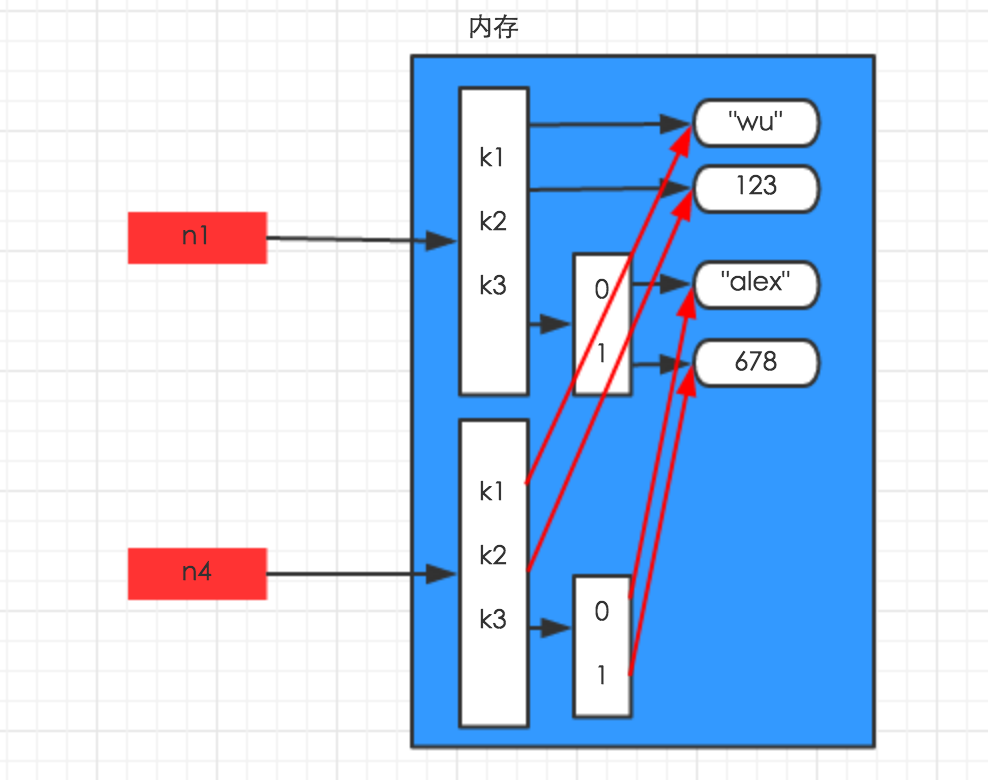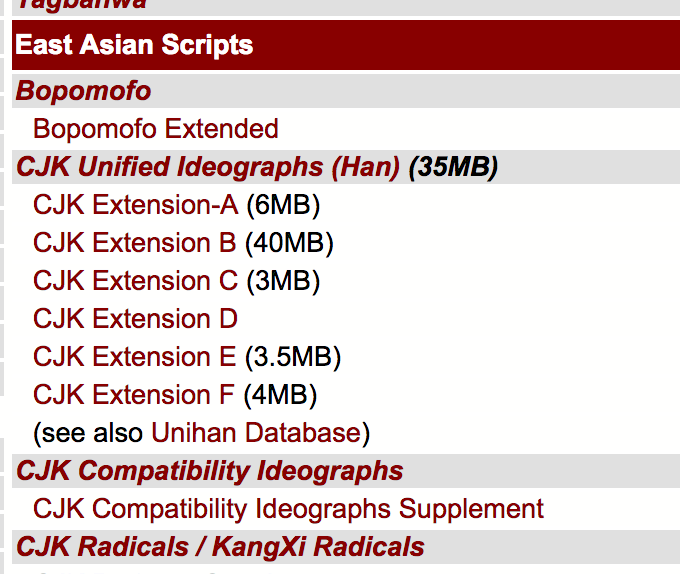本节内容
一、三元运算
三元运算又称三目运算,是对简单的条件语句的简写,如:
简单条件语句:
if 条件成立:
val = 1
else:
val = 2
改成三元运算:
val = 1 if 条件成立 else 2
二、深浅拷贝
浅拷贝
浅拷贝,在内存中只额外创建第一层数据
import copy
n1 = {"k1": "wu", "k2": 123, "k3": ["alex", 456]}
n3 = copy.copy(n1)

深拷贝
深拷贝,在内存中将所有的数据重新创建一份(排除最后一层,即:python内部对字符串和数字的优化)
import copy
n1 = {"k1": "wu", "k2": 123, "k3": ["alex", 456]}
n4 = copy.deepcopy(n1)

三、字符编码转换
编码的种类情况
- ASCII 占1个字节,只支持英文
- GB2312 占2个字节,支持6700+汉字
- GBK GB2312的升级版,支持21000+汉字
- Shift-JIS 日本字符
- ks_c_5601-1987 韩国编码
- TIS-620 泰国编码
由于每个国家都有自己的字符,所以其对应关系也涵盖了自己国家的字符,但是以上编码都存在局限性,即:仅涵盖本国字符,无其他国家字符的对应关系。应运而生出现了万国码,他涵盖了全球所有的文字和二进制的对应关系。
- Unicode 2-4字节 已经收录136690个字符,并还在一直不断扩张中...
Unicode 起到了2个作用:
- 直接支持全球所有语言,每个国家都可以不用再使用自己之前的旧编码了,用unicode就可以了。(就跟英语是全球统一语言一样)
- unicode包含了跟全球所有国家编码的映射关系,为什么呢?后面再讲
Unicode解决了字符和二进制的对应关系,但是使用unicode表示一个字符,太浪费空间。例如:利用unicode表示“Python”需要12个字节才能表示,比原来ASCII表示增加了1倍。
Unicode解决了字符和二进制的对应关系,但是使用unicode表示一个字符,太浪费空间。例如:利用unicode表示“Python”需要12个字节才能表示,比原来ASCII表示增加了1倍。
由于计算机的内存比较大,并且字符串在内容中表示时也不会特别大,所以内容可以使用unicode来处理,但是存储和网络传输时一般数据都会非常多,那么增加1倍将是无法容忍的!!!
为了解决存储和网络传输的问题,出现了Unicode Transformation Format,学术名UTF,即:对unicode中的进行转换,以便于在存储和网络传输时可以节省空间!- UTF-8: 使用1、2、3、4个字节表示所有字符;优先使用1个字符、无法满足则使增加一个字节,最多4个字节。英文占1个字节、欧洲语系占2个、东亚占3个,其它及特殊字符占4个。
- UTF-16: 使用2、4个字节表示所有字符;优先使用2个字节,否则使用4个字节表示。
- UTF-32: 使用4个字节表示所有字符。
总结:UTF 是为unicode编码 设计 的一种 在存储 和传输时节省空间的编码方案。
字符在硬盘上的存储
无论以什么编码在内存里显示字符,存到硬盘上都是2进制。注意:存到硬盘上时是以什么编码存的,再从硬盘上读出来时,就必须以什么编码读,要不然会乱的。
编码的转换
unicode其中一个功能是其包含了跟全球所有国家编码的映射关系,意思就是,你写的是gbk的“人生苦短 我用python”,但是unicode能自动知道它在unicode中的“人生苦短 我用python”的编码是什么,如果这样的话,那是不是意味着,无论你以什么编码存储的数据,只要你的软件在把数据从硬盘读到内存里,转成unicode来显示,就可以了。由于所有的系统、编程语言都默认支持unicode,那你的gbk软件放到美国电脑上,加载到内存里,变成了unicode,中文就可以正常展示啦。
unicode与gbk的映射表 http://www.unicode.org/charts/

Python的执行过程
- 解释器找到代码文件,把代码字符串按文件头定义的编码加载到内存,转成unicode.
- 把代码字符串按照语法规则进行解释.
- 所有的变量字符都会以unicode编码声明.
编码转换过程
python3 默认编码是‘utf-8’,而python2的默认编码是ASCII.
utf-8编码之所以能在windows gbk的终端下显示正常,是因为到了内存里python解释器把utf-8转成了unicode , 但是这只是python3, 并不是所有的编程语言在内存里默认编码都是unicode,比如 万恶的python2 就不是, 它的默认编码是ASCII,想写中文,就必须声明文件头的coding为gbk or utf-8, 声明之后,python2解释器仅以文件头声明的编码去解释代码,加载到内存后,并不会主动帮你转为unicode,也就是说,你的文件编码是utf-8,加载到内存里,你的变量字符串就也是utf-8。。。意味着,你以utf-8编码的文件,在windows是乱码。
只有两种情况下,在windows上显示才不会乱:①.字符串以GBK格式显示 ②.字符串是Unicode编码的。
既然Python2不会自动的把文件编码转换为Unicode存到内存里,那就只能自己动手转了。而python3自动把文件编码转换为Unicode,是调用了decode(解码) 和 encode(编码)。
UTF-8 --> decode 解码 --> Unicode Unicode --> encode 编码 --> GBK / UTF-8 ..

常见编码错误的原因有:
- Python解释器的默认编码
- Python源文件文件编码
- Terminal使用的编码
- 操作系统的语言设置 掌握了编码之前的关系后,挨个排错就好啦
四、文件处理

class file(object) def close(self): # real signature unknown; restored from __doc__ 关闭文件 """ close() -> None or (perhaps) an integer. Close the file. Sets data attribute .closed to True. A closed file cannot be used for further I/O operations. close() may be called more than once without error. Some kinds of file objects (for example, opened by popen()) may return an exit status upon closing. """ def fileno(self): # real signature unknown; restored from __doc__ 文件描述符 """ fileno() -> integer "file descriptor". This is needed for lower-level file interfaces, such os.read(). """ return 0 def flush(self): # real signature unknown; restored from __doc__ 刷新文件内部缓冲区 """ flush() -> None. Flush the internal I/O buffer. """ pass def isatty(self): # real signature unknown; restored from __doc__ 判断文件是否是同意tty设备 """ isatty() -> true or false. True if the file is connected to a tty device. """ return False def next(self): # real signature unknown; restored from __doc__ 获取下一行数据,不存在,则报错 """ x.next() -> the next value, or raise StopIteration """ pass def read(self, size=None): # real signature unknown; restored from __doc__ 读取指定字节数据 """ read([size]) -> read at most size bytes, returned as a string. If the size argument is negative or omitted, read until EOF is reached. Notice that when in non-blocking mode, less data than what was requested may be returned, even if no size parameter was given. """ pass def readinto(self): # real signature unknown; restored from __doc__ 读取到缓冲区,不要用,将被遗弃 """ readinto() -> Undocumented. Don't use this; it may go away. """ pass def readline(self, size=None): # real signature unknown; restored from __doc__ 仅读取一行数据 """ readline([size]) -> next line from the file, as a string. Retain newline. A non-negative size argument limits the maximum number of bytes to return (an incomplete line may be returned then). Return an empty string at EOF. """ pass def readlines(self, size=None): # real signature unknown; restored from __doc__ 读取所有数据,并根据换行保存值列表 """ readlines([size]) -> list of strings, each a line from the file. Call readline() repeatedly and return a list of the lines so read. The optional size argument, if given, is an approximate bound on the total number of bytes in the lines returned. """ return [] def seek(self, offset, whence=None): # real signature unknown; restored from __doc__ 指定文件中指针位置 """ seek(offset[, whence]) -> None. Move to new file position. Argument offset is a byte count. Optional argument whence defaults to (offset from start of file, offset should be >= 0); other values are 1 (move relative to current position, positive or negative), and 2 (move relative to end of file, usually negative, although many platforms allow seeking beyond the end of a file). If the file is opened in text mode, only offsets returned by tell() are legal. Use of other offsets causes undefined behavior. Note that not all file objects are seekable. """ pass def tell(self): # real signature unknown; restored from __doc__ 获取当前指针位置 """ tell() -> current file position, an integer (may be a long integer). """ pass def truncate(self, size=None): # real signature unknown; restored from __doc__ 截断数据,仅保留指定之前数据 """ truncate([size]) -> None. Truncate the file to at most size bytes. Size defaults to the current file position, as returned by tell(). """ pass def write(self, p_str): # real signature unknown; restored from __doc__ 写内容 """ write(str) -> None. Write string str to file. Note that due to buffering, flush() or close() may be needed before the file on disk reflects the data written. """ pass def writelines(self, sequence_of_strings): # real signature unknown; restored from __doc__ 将一个字符串列表写入文件 """ writelines(sequence_of_strings) -> None. Write the strings to the file. Note that newlines are not added. The sequence can be any iterable object producing strings. This is equivalent to calling write() for each string. """ pass def xreadlines(self): # real signature unknown; restored from __doc__ 可用于逐行读取文件,非全部 """ xreadlines() -> returns self. For backward compatibility. File objects now include the performance optimizations previously implemented in the xreadlines module. """ pass

class TextIOWrapper(_TextIOBase): """ Character and line based layer over a BufferedIOBase object, buffer. encoding gives the name of the encoding that the stream will be decoded or encoded with. It defaults to locale.getpreferredencoding(False). errors determines the strictness of encoding and decoding (see help(codecs.Codec) or the documentation for codecs.register) and defaults to "strict". newline controls how line endings are handled. It can be None, '', ' ', ' ', and ' '. It works as follows: * On input, if newline is None, universal newlines mode is enabled. Lines in the input can end in ' ', ' ', or ' ', and these are translated into ' ' before being returned to the caller. If it is '', universal newline mode is enabled, but line endings are returned to the caller untranslated. If it has any of the other legal values, input lines are only terminated by the given string, and the line ending is returned to the caller untranslated. * On output, if newline is None, any ' ' characters written are translated to the system default line separator, os.linesep. If newline is '' or ' ', no translation takes place. If newline is any of the other legal values, any ' ' characters written are translated to the given string. If line_buffering is True, a call to flush is implied when a call to write contains a newline character. """ def close(self, *args, **kwargs): # real signature unknown 关闭文件 pass def fileno(self, *args, **kwargs): # real signature unknown 文件描述符 pass def flush(self, *args, **kwargs): # real signature unknown 刷新文件内部缓冲区 pass def isatty(self, *args, **kwargs): # real signature unknown 判断文件是否是同意tty设备 pass def read(self, *args, **kwargs): # real signature unknown 读取指定字节数据 pass def readable(self, *args, **kwargs): # real signature unknown 是否可读 pass def readline(self, *args, **kwargs): # real signature unknown 仅读取一行数据 pass def seek(self, *args, **kwargs): # real signature unknown 指定文件中指针位置 pass def seekable(self, *args, **kwargs): # real signature unknown 指针是否可操作 pass def tell(self, *args, **kwargs): # real signature unknown 获取指针位置 pass def truncate(self, *args, **kwargs): # real signature unknown 截断数据,仅保留指定之前数据 pass def writable(self, *args, **kwargs): # real signature unknown 是否可写 pass def write(self, *args, **kwargs): # real signature unknown 写内容 pass def __getstate__(self, *args, **kwargs): # real signature unknown pass def __init__(self, *args, **kwargs): # real signature unknown pass @staticmethod # known case of __new__ def __new__(*args, **kwargs): # real signature unknown """ Create and return a new object. See help(type) for accurate signature. """ pass def __next__(self, *args, **kwargs): # real signature unknown """ Implement next(self). """ pass def __repr__(self, *args, **kwargs): # real signature unknown """ Return repr(self). """ pass buffer = property(lambda self: object(), lambda self, v: None, lambda self: None) # default closed = property(lambda self: object(), lambda self, v: None, lambda self: None) # default encoding = property(lambda self: object(), lambda self, v: None, lambda self: None) # default errors = property(lambda self: object(), lambda self, v: None, lambda self: None) # default line_buffering = property(lambda self: object(), lambda self, v: None, lambda self: None) # default name = property(lambda self: object(), lambda self, v: None, lambda self: None) # default newlines = property(lambda self: object(), lambda self, v: None, lambda self: None) # default _CHUNK_SIZE = property(lambda self: object(), lambda self, v: None, lambda self: None) # default _finalizing = property(lambda self: object(), lambda self, v: None, lambda self: None) # default
读
#1. 打开文件,得到文件句柄并赋值给一个变量
f=open('a.txt','r',encoding='utf-8') #默认打开模式就为r
#2. 通过句柄对文件进行操作
data=f.read()
#3. 关闭文件
f.close()
PS: 此处的encoding必须和文件在保存时设置的编码一致,不然“断句”会不准确从而造成乱码。
打开文件的模式有:
- r ,只读模式【默认】
- w,只写模式【不可读;不存在则创建;存在则清空内容;】
- x, 只写模式【不可读;不存在则创建,存在则报错】
- a, 追加模式【可读; 不存在则创建;存在则只追加内容;】
"+" 表示可以同时读写某个文件
- r+, 读写【可读,可写】
- w+,写读【可读,可写】
- x+ ,写读【可读,可写】
- a+, 写读【可读,可写】
"b"表示以字节的方式操作
- rb 或 r+b
- wb 或 w+b
- xb 或 w+b
- ab 或 a+b
注:以b方式打开时,读取到的内容是字节类型,写入时也需要提供字节类型
操作方法
def fileno(self, *args, **kwargs): # real signature unknown
返回文件句柄在内核中的索引值,以后做IO多路复用时可以用到
def flush(self, *args, **kwargs): # real signature unknown
把文件从内存buffer里强制刷新到硬盘
def readable(self, *args, **kwargs): # real signature unknown
判断是否可读
def readline(self, *args, **kwargs): # real signature unknown
只读一行,遇到
or
为止
def seek(self, *args, **kwargs): # real signature unknown
把操作文件的光标移到指定位置
*注意seek的长度是按字节算的, 字符编码存每个字符所占的字节长度不一样。
如“月光之城” 用gbk存是2个字节一个字,用utf-8就是3个字节,因此以gbk打开时,seek(4) 就把光标切换到了“光”和“之”两个字中间。
但如果是utf8,seek(4)会导致,拿到了光这个字的一部分字节,打印的话会报错,因为处理剩下的文本时发现用utf8处理不了了,因为编码对不上了。少了一个字节
def seekable(self, *args, **kwargs): # real signature unknown
判断文件是否可进行seek操作
def tell(self, *args, **kwargs): # real signature unknown
返回当前文件操作光标位置
def truncate(self, *args, **kwargs): # real signature unknown
按指定长度截断文件
*指定长度的话,就从文件开头开始截断指定长度,不指定长度的话,就从当前位置到文件尾部的内容全去掉。
def writable(self, *args, **kwargs): # real signature unknown
判断文件是否可写
#掌握
f.read() #读取所有内容,光标移动到文件末尾
f.readline() #读取一行内容,光标移动到第二行首部
f.readlines() #读取每一行内容,存放于列表中
f.write('1111
222
') #针对文本模式的写,需要自己写换行符
f.write('1111
222
'.encode('utf-8')) #针对b模式的写,需要自己写换行符
f.writelines(['333
','444
']) #文件模式
f.writelines([bytes('333
',encoding='utf-8'),'444
'.encode('utf-8')]) #b模式
f.closed #文件是否关闭
f.encoding #如果文件打开模式为b,则没有该属性
f.flush() #立刻将文件内容从内存刷到硬盘
f.name
为了避免打开文件后忘记关闭,可以通过管理上下文,即:
with open('web','r') as f:
pass
如此方式,当with代码块执行完毕时,内部会自动关闭并释放文件资源。
在Python 2.7 及以后,with又支持同时对多个文件的上下文进行管理,即:
with open('web1') as obj1, open('web2') as obj2:
pass
文件的修改
文件的数据是存放于硬盘上的,因而只存在覆盖、不存在修改这么一说,我们平时看到的修改文件,都是模拟出来的效果,具体的说有两种实现方式:
方式一:将硬盘存放的该文件的内容全部加载到内存,在内存中是可以修改的,修改完毕后,再由内存覆盖到硬盘(word,vim,nodpad++等编辑器)
import os
with open('a.txt') as read_f,open('.a.txt.swap','w') as write_f:
data=read_f.read() #全部读入内存,如果文件很大,会很卡
data=data.replace('alex','SB') #在内存中完成修改
write_f.write(data) #一次性写入新文件
os.remove('a.txt')
os.rename('.a.txt.swap','a.txt')
复制代码
方式二:将硬盘存放的该文件的内容一行一行地读入内存,修改完毕就写入新文件,最后用新文件覆盖源文件
import os
with open('a.txt') as read_f,open('.a.txt.swap','w') as write_f:
for line in read_f:
line=line.replace('alex','SB')
write_f.write(line)
os.remove('a.txt')
os.rename('.a.txt.swap','a.txt')
